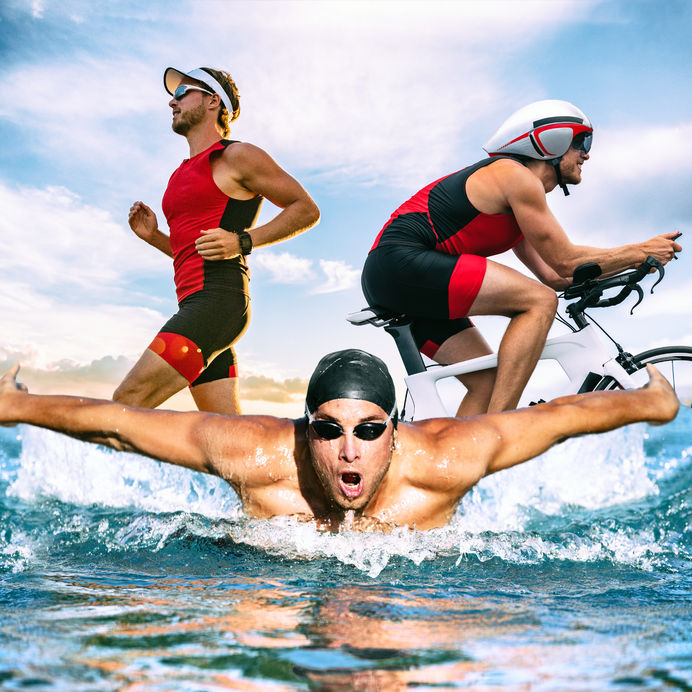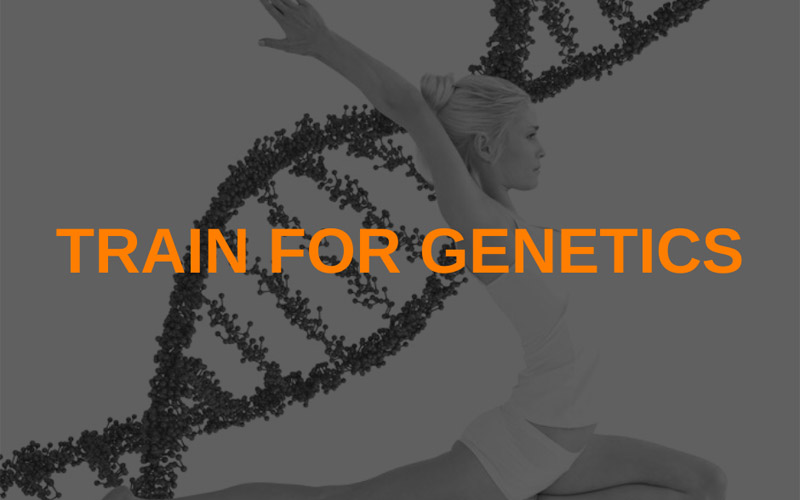In the world of fitness, most of us professionals have figured out that there really isn’t a one-size-fits-all approach to personal training. Our clients have different lifestyles, different goals, different preferences, and most certainly different genetics. How can we as trainers harness our clients’ full potential based on their natural predilections, even without the information their DNA might more easily convey?
How Genetics Influence Athleticism and Ability
Body Types. We can start with visual assessment of our clients to gain the most basic information. Is s/he clearly an ectomorph (larger boned), a mesomorph (more muscle definition), an ectomorph (slight bone structure), or some combination of these? We know from our NFPT manual that we would train these three individuals completely differently if they fell neatly into a particular category.
Most likely an endomorph is looking to lose weight, so we would apply a fat loss program to achieve that goal. Easy, right?
A mesomorph likely puts on muscle easily, but that doesn’t mean they have no fat to lose. What do they want? More muscle or less? Get those goals down pat first and figure out with your client if a typical hypertrophy program is called for to gain lean mass, or perhaps a more general fitness approach to minimize muscle development while still improving overall fitness.
How about an ectomorph? Most likely this client doesn’t have weight to lose, but that doesn’t mean their body composition is ideal. Intuitively, this person’s appearance would probably benefit from heavier resistance training, but is working out this way what they would most enjoy? Would their body even respond well?
Muscle Composition. Here’s where specific genetic tendencies can make this periodization plan a little tricky. The above categories are super generalized, and don’t take into account specific muscle fiber composition. You can have an ectomorph that genetically has far more Type I fibers and will have a very hard time responding to strength training. Or an ectomorph with a higher threshold for cardiovascular endurance than the endomorph that has a lot of fat to lose. And even more confusing, you could have a mesomorph with a higher proportion of Type II fibers in their lower body than upper body and who feels frustrated by their inability to put size on her arms.
Nutritional Profile. Furthermore, an endomorph who has a spare tire to lose may not know that their low-fat, low-carb diet is actually not conducive to their genetic ability to shed extra weight. This is a tough one. While a caloric deficit ultimately determines how much fat can be burned metabolically, there are also genetic markers that indicate some folks are more efficient at utilizing carbohydrates than others, while some can handle a higher fat diet than others. Still others fare best with more protein and fewer carbs. Macronutrient profile aside, how healthy is your client eating on a regular basis? No fruit or veggies and lots of fried food is good for no one.
Genetics Analysis
For some clients, they may be motivated to find out more about their genetic markers and how it influences their athleticism, their dietary needs, even things like rest and caffeine metabolism. I had an analysis performed by 23andme.com a few years ago which gave me some basic information, and then later, was able to order a more thorough dietary analysis through genopalate.com using the same analysis done by 23andme.com.
The results were very interesting to me. It told me a lot of things I already knew or had an inkling about (like, I’m a light sleeper and am lactose intolerant). But it was affirming to learn that I have genetic markers that indicate I would excel at sprinting and strength training, and also, that I require slightly more protein and less fat than the average person.
Not everyone is attuned to their body and its needs. Such an analysis can help steer those who feel they lack direction or perhaps are “convinced” they need to follow a certain path because it worked so well for someone else; they may find their path to success does and should look very different. Since not everyone will feel comfortable seeking this information, there are still things fitness coaches can look for to help point their clients in the right direction.
How Preferences Can Point You in the Right Direction
 It doesn’t take a rocket scientist to see the aesthetic differences between a marathon runner and a sprinter—a gymnast and a linebacker–a boxer and a wrestler–a ballet dancer and a tennis player. It’s no accident that athletes seek out the activities they are best suited for, and then excel at them based on their genetics. Now, for our general fitness and weight loss clients, these phenotypical characteristics may be less obvious. But with a little digging and observation, you can probably figure out what activities your client will respond to best, both physically and emotionally.
It doesn’t take a rocket scientist to see the aesthetic differences between a marathon runner and a sprinter—a gymnast and a linebacker–a boxer and a wrestler–a ballet dancer and a tennis player. It’s no accident that athletes seek out the activities they are best suited for, and then excel at them based on their genetics. Now, for our general fitness and weight loss clients, these phenotypical characteristics may be less obvious. But with a little digging and observation, you can probably figure out what activities your client will respond to best, both physically and emotionally.
If your client is a beginner and is just starting out with you, do a thorough consultation and history. Did they play sports as a teen? Did they love it or hate? Or did they excel? Have they exercised consistently in the past? What worked best? What did they enjoy most? Or have they tried every workout routine under the sun, but nothing ever stuck?
Have they ever run a marathon or does that sound like torture to them? Do they run 5ks or maybe just walk them? Did they tell you they hate running but love Zumba? Maybe they were successful doing P90X at home but didn’t like working with the trainer that put them on a machine circuit every time.
Observe their mannerisms and the way they move. Do they move and talk slowly and deliberately? Or are they fast talkers? Perhaps nervous or fidgety? If you get them to warm up is it slow going or are they ready to bust out jumping jacks and burpees right out of the gate? Are they hypermobile and great at yoga, or super stiff and hate stretching? These tendencies are clues to not only energy levels and preferences, but muscle fiber recruitment and aerobic capacity.
Taking these clues and formulating a program around both the client’s goals and his or her predilections will likely lead to achieving those goals while also helping them to enjoy the workout in the process.
Not the End All or Be All
This is not to say that you should avoid all activities that seem to run counter to their genetic tendencies. On the contrary, proper periodization dictates cycling clients through varying intensities and volume through the course of their programming. Not to mention, a lot of the time when someone avoids a particular activity or exercise, it might be something they really need to—a weak link that needs to be brought up to speed. I’ve always said to my clients, “If you hate it, you probably need to do it.” There are plenty of exceptions to this, of course, but do note if an area could use some extra work, and your client is only avoiding it because s/he never had a chance to bring it up to speed.
Additionally, science has pointed to the likelihood that muscle fiber composition can change by training that fiber type more heavily. So if someone really wants to run a marathon but appears more suited for short-distance running, a creative trainer and a determined client can make it happen with focus and smart training.
A client’s motivation, whether it be intrinsic or extrinsic, also plays a key role in how creative you might get with your programming. Is someone in it just to “move more” and stay healthy and fit? If so, lots of variation to stave off boredom will work well with this client, and giving them activities and exercises they enjoy will keep them more engaged with you.
For someone who has a very concrete goal in mind, such as losing 10 pounds in three months, adding 100 pounds to their barbell squat, or training for a 5k, they will more likely appreciate your expertise in programming in such a way that gets them to their goal the fastest. And still others might not have any concrete goal, but won’t feel you are worth their time or money if they aren’t lying in a pool of their own sweat at the end of every session.
The art and skill of a talented personal trainer is learning to strike the balance between pushing a client just past their comfort zone, while also giving them activities that they both enjoy and want to continue performing that will help them achieve their goals. They might also greatly appreciate the reassurance that they don’t have to be good at everything they attempt in the gym—some people were born ready to bench twice their body weight and others can easily train for a sub 6-minute mile for their very first 5k. It’s your job to help your client find what they were born to do and help them reach their goals by doing it even better.
NFPT Publisher Michele G Rogers, MA, NFPT-CPT and EBFA Barefoot Training Specialist manages and coordinates educational blogs and social media content for NFPT, as well as NFPT exam development. She’s been a personal trainer and health coach for over 20 years fueled by a lifetime passion for all things health and fitness. Her mission is to raise kinesthetic awareness and nurture a mind-body connection, helping people achieve a higher state of health and wellness. After battling and conquering chronic back pain and becoming a parent, Michele aims her training approach to emphasize fluidity of movement, corrective exercise, and pain resolution. She holds a master’s degree in Applied Health Psychology from Northern Arizona University. Follow Michele on Instagram.


